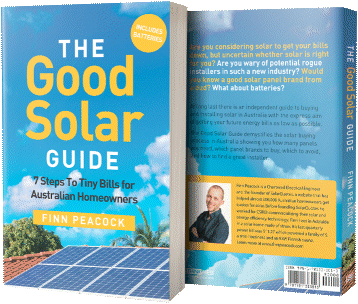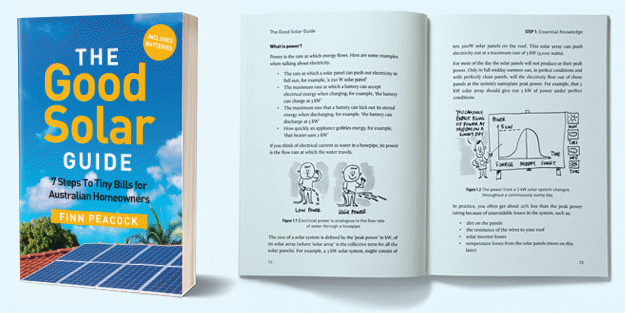
Draft determinations for default electricity offer pricing for 2025/26 have been announced for South East Queensland, New South Wales, South Australia and Victoria for 2025/26. Here’s what’s on the cards.
The Australian Energy Regulator (AER) yesterday announced its draft determination for the Default Market Offer (DMO) covering NSW, SEQ and SA customers. Victoria’s Essential Services Commission (ESC) also released its draft decision on the 2025-26 Victorian Default Offer (VDO).
But first, just briefly …
What Are Default Electricity Offers?
Default/standing offers are meant to act as safety nets of sorts for customers who don’t choose a market plan for whatever reason. While default offers only directly affect a minority of electricity customers1 as most choose a market offer, they have broader importance as they set the stage for market offer pricing. If default offer costs go up, it’s likely other plans will too.
Changes In A Nutshell
So, with that in mind, here’s a summary of the cost impacts of proposed changes to default offer pricing for the 2025/26 financial year.
Residential (without controlled load)
- South East Queensland: + 5.8%
- New South Wales: +7.8% – +8.8%
- South Australia: +5.1%
- Victoria: Average of less than +1%
Note: “controlled load” is explained here (second subheading), but essentially these are special electricity tariffs (that may go by another name) for appliances that are separately metered; such as some electric hot water systems.
Residential (with controlled load)
- South East Queensland: + 2.5%
- New South Wales: +8.2% – +8.9%
- South Australia: +4.4%
- Victoria: Not specified
Small Business
- South East Queensland: +4.2%
- New South Wales: +7.7% – 8.2%
- South Australia: +6.6%
- Victoria: Average of +3%
Reasons Given For The Rises
While rises in SEQ, NSW and SA aren’t as high as in some recent years, any increase just adds to already considerable cost of living pain. The AER says it’s seen upward cost pressures across nearly every component of the DMO. The Regulator points to average wholesale market spot prices increasing across 2024 due to issues including high demand, coal generator and network outages, and “low” solar and wind output (?)2 driving high price events. This has also affected the price of wholesale electricity contracts for 2025–26. Electricity retailer costs have also increased.
Commenting on the draft AER decision, the Institute For Energy Economics And Financial Analysis (IEEFA) Australia’s Lead Electricity Analyst Johanna Bowyer highlighted the role of gas prices.
“A key driver of wholesale price rises over the past decade is gas prices. Gas prices have come down from record levels seen a few years ago, but still remain elevated compared to historical levels.”
In Victoria, the Essential Services Commission says higher electricity network costs for residential were partially offset by lower wholesale and environmental costs. While for business, higher wholesale and network costs were partially offset by lower environmental costs.
Both the ESC and AER’s decisions are not yet final. Consultation on the ESC’s draft decision runs until 11 April 2025, with the Commission’s final decision due by 24 May 2025. The AER is inviting written submissions by close of business 3 April 2025, with the final decision to be published on 26 May 2025.
What About Default Offers In Other States?
In Tasmania, that job falls to the Tasmanian Economic Regulator, which tends to leave it until late June to announce changes. Across in Western Australia, regulated electricity prices are determined by the State Government annually as part of the State Budget process.
In the Northern Territory, The NT Government determines all power tariffs and charges – and usually leaves it until the last minute to announce changes for the new financial year. And in the ACT, the Independent Competition and Regulatory Commission (ICRC) sets standing offers for the new financial year. Last year that occurred in late May.
For Even More Expensive Electricity, Just Add Nuclear
So, is nuclear energy the answer to taming electricity prices in Australia? Over to the IEEFA’s Johanna Bowyer again.
“Nuclear is one of the most expensive electricity solutions. If nuclear power was introduced into the grid, we have calculated this could lead to energy bill rises of $665 per year for a typical household, or $972 for a 4-person household, in a situation in which nuclear reactors recover their costs through bills.”
IEEFA’s report on the potential impact of nuclear power on electricity prices in Australia was published in September last year and can be found here.
Ms. Bowyer says more renewable energy entering the system would drive further wholesale price reductions, and there are opportunities for bringing network costs down too.
“Network businesses are achieving supernormal profits, and tightening up the regulations could reduce bills by around $120 per year.”
Shop Around, Go Solar, Boost Energy Efficiency
As standing offers are safety nets, they don’t offer the cheapest prices – and even market offers can vary wildly. It pays to regularly compare electricity plans to avoid falling victim to a “loyalty tax”. And for those who are able to do so and haven’t already, they can join the millions of Australians living in households with low electricity bills thanks to their rooftop solar power systems.
Even without solar panels, households can save a bundle by taking a closer look at the energy efficiency of their homes. For solar owners, having an energy-efficient home is also important, as their mains grid consumption is usually in the evenings and early mornings when their systems aren’t producing – and this is where home batteries can also come into play.
Footnotes
- Around 8.1% of residential and 17.8% of small business customers in SEQ, NSW and SA (collectively) are on standing offers. In Victoria, 13 per cent of households and 20 per cent of small business customers are on that state’s Default Offer. ↩
- From what I can tell after a quick look at OpenElectricity, wind and solar power’s contribution to mains grid demand in SA, NSW and Queensland were collectively *up* in 2024 compared to 2023. While wind power’s contribution to demand in SA was down last year, it more than offset by solar energy contributions. But when it comes to wholesale prices, timing is everything. ↩

 RSS - Posts
RSS - Posts



If the price of power does increase the payback on batteries only shortens. Solar highly recommend putting at least 9.4-18 kW array even in Victoria where Winter months see 1/4 of Summer month generation but battery payback and ability to store is significantly hampered over late April to early August. When battery cost comes down to around $500.00/ kWh them payback will be around 4 years in Victoria southern regions.
SQ’s reported power rises don’t even come close to justifying a battery. Last time I priced it out it took far longer than a decade to pay for itself. Worse, that was before being offered an increase in FiTs and a reduction in charges. Assuming the plan changes parallel what SQ has said, then I’ll be paying less next financial year than I was last!
Obviously YMMV when it comes to determining battery payback periods – I’m fairly sure they weren’t even remotely close to $500/kWh! The general rule seems to be the larger the system, the greater your usage, and the more you pay per kWh, the sooner a battery system pays for itself. But if you have low usage, low charges, and a small system it takes a looong time to pay for itself.
solarquotes has a very good battery calculator. Payback was calculated at 11 years for me for a sensibly sized battery. I think I used a 13kW BYD in my calculation.
As prices go up, that payback shortens.
I can upload 2 years of actual Energex smart meter data directly into the calculator for accurate solar generation and battery cycle calculations.
As soon as my heatpump hot water system is repaid, I am installing a battery.
I just watched an interview with an Independent PM , her solution was just put more solar panels on your roof . Yep great except for …. Home Units , apartments , people renting , those living department of housing , Factorys , small businesses .. the list goes on and on , just shows these Independants and Labour are Clueless
There’s an EU-funded pilot geothermal energy project at Geretsried, in Bavaria, coming on stream in a couple of months. If it flies, then nuclear is not only redundant, but obsoleted commercially. The pilot commercial plant is, based on experience with an experimental installation in Canada, and is projected to produce 8.2 MW electrical + 64 MW thermal for city domestic heating, reticulated in insulated pipes – standard in northern Europe.
Unlike old geothermal, it only needs solid rock, 7 km down, no aquifer, no fracking, so goes almost anywhere. Unlike nuclear, it is dispatchable; during peak solar production, just stop drawing the heated water. (Which thermosiphons in operation, so no pump losses.)
Construction time is 2 yrs, not 23, like nuclear. Deep drilling of a multi-pipe heat exchanger is quite expensive (ask oil drillers), but not remotely irrecoverably expensive like nuclear.
While the next one will doubtless be significantly larger, they seem ideally suited to regional generation; local geothermal heat backing up local batteries, solar & wind. Then the grid is only for sharing excess. When it goes down, then OK, try to fix it next week if that suits – no hurry.
Solar obsoletes nuclear fusion; the reactor is free, and you don’t need wires!
Geothermal obsoletes fission; the reactor is deeply buried & free, and energy extraction is 10 times faster & cheaper to build.
And geothermal reduces the extent of grid-scale battery firming required.
Eavor have follow-up projects in the pipeline, at different phases. Australia doesn’t have as much shallow heat as better spots, so might prefer to wait for the deeper drilling tech, being developed in New Mexico now, to commercialise.
There can easily be geothermal everywhere in 20 years, well before a nuclear power plant could be built in Australia.
Sadly an Australian project that successfully demonstrated “hot rock” power generation near Cooper Pedy had to close down due to a lack of government and energy-industry support:
https://reneweconomy.com.au/geodynamics-completes-testing-at-1mw-geothermal-trial-plant-72641/
Ironically the source of heat is nuclear – natural radioactivity in granite domes several km underground. If only the COALition had backed it! There are many of these domes scattered around Australia. It would only take a few years to bring them online, provided that drilling rigs are not fully committed to finding oil and gas (as happened with the trial project by Geodynamics and other geothermal projects around the world).
Maybe the technology can be revived for the reasons you outline above.
Sounds a little like America’s Quaise Energy, though they’re looking at 20km rather than 7km. They’ve been working on the problem since 2018, were supposed to have their drilling rig completed last year, and a small powerplant running by either 2026 or 2028.
I remain a fan of nuclear technology for a variety of reasons, but having multiple sources of power is a much wiser option than single focus.
Hi George,
You do realise that nuclear is just a stalking horse for years more business as usual coal and gas?
It’s never actually going to be built in Australia.
While it is easy to write “20 km deep”, that cost is staggeringly unviable, and the time taken barely believable. The reason for 7 km is that that is commercially viable with current technology – the energy can be sold at a competitive price. Eavor has a research installation in New Mexico, which is developing the technology to allow drill tooling to survive long enough to economically drill deeper than 7 km, seeking higher power plant operating temperatures.
OK, there’s a mob touting microwave deep bore drilling, not susceptible to tooling overheating, but it seems, so far, to be a case of “We think we can make it work, and one day it could happen.” If so, the 20 km might come to pass. If.
Now, 10 km will be better than 7 km, for efficiency and higher output, but we don’t need it perfect, we just need it Now, to destroy the economics of fossil fuelled power generation. We’ll still hit +2 degC by 2032, and +3 degC before 2050, I figure, because of response lag, and the 90% of the overheat going into oceans coming out again, but overshoot is better than no return.
(Assuming the feedbacks die down in a few centuries. It is without doubt mankind’s most courageous experiment.)
The only thing which has zero chance is nuclear, as commissioning in 2048 is far too late. The budget & resource demands in an unameliorated climate hell of fires, floods, and cyclones, dwarfing anything we’ve ever seen, would unavoidably divert completion funding to something, anything, which would *actually* help before the Titanic has sunk.
Stay dry, stay high, and keep the grass short.
Buried in the AER paperwork are factors such as:
* Reduced demand for fossil-fuelled electricity due to the rise of renewables, especially home solar & batteries
* So less income for these suppliers for covering their overheads
* As pointed out above, higher fossil fuel costs, including maintaining ancient coal-fired power stations
One “reason” put forward for the increases was that administrative and advertising costs were higher! Why should current consumers have to pay for advertising? These companies need to show that they are reducing overheads (exec salaries!) before any increase is granted.
The grid electricity death spiral is real. There are more than a few academic papers written about it now.
This could all have been avoided if they hadn’t gone ahead with that ridiculous gold plating public/private partnership scheme back in the early 00s. It really was the grid’s death knell.
Sodium Ion batteries are already gaining use in Chinese vehicles. They cost 60% of LiFePO4 and will be far lest dangerous than LCM batteries. No risk of thermal runaway and operate at much higher temps thus suited for Aussie Summer heat.
They are slightly larger by about 20% than LFP but for home storage the issue of size is not so problematic.
It wont be long before Sodium Ion batteries are here for home storage.
You are right that LiFePO₄ batteries are enormously safer than NCM (ordinary Li-Ion) batteries, in that thermal runaway is essentially unknown. BYD’s blade batteries can be seen cooking on a stove without problems, and they drive a large spike through one to demonstrate puncture immunity.
I’ve looked for LiFePO₄ fires around the world, and have so far only found one case of smoke emission, whose stains on the garage wall could be wiped off with a wet cloth. The fire brigade had been called, but stayed only briefly, out of curiosity. (They’d never heard of a LiFePO₄ fire, either.)
I’ve ensured my BEV and solar installation both use LiFePO₄, for safety, SoC insensitivity, and cost saving. (46 kWh with 3 BMSs, for $18k is $391 / kWh. It just did not have to be cheaper than that, in 2024, I figure.) Even if you buy 5 kWh rack mount LiFePO₄ batteries for $2700 each today, that’s $540 / kWh, more convenient than DIY. Three of them give 15 kWH for $8100 vs $15k for a Tesla Powerwall, whose inbuilt inverter is excess baggage if you have a battery-ready hybrid inverter, or off-grid system with battery inverter(s).
While it’ll probably not be too hard to get used to it, the very saggy discharge curve of Sodium Ion means that inverter efficiency will decrease with DoD (lower SoC). I’m not sure that the greatest contribution made by them will not be merely to reduce LiFePO₄ prices through competition.
Its all depends which component is going up. supply charges (poles and wires), retailers fees or electricity price and feed in tariffs.. Last year, my electricity price came down, supply charges went up substantially and feed in tariffs went down. Which is worst case senario, feedin credits no longer cover the fixed costs and for me the electricity price is irrelevent, total import of 2kWh (when I forgot to turn of heating overnight in middle of winter). So as far as battery payback, went backwards.
While I would not wish it on all the non solar and solar/battery people, for me, the opposite needs to happen. What would be great is time based manadated feedin tariffs that reflect the wholesale pricing across a day, with me in control of battery discharge (lots of spare capacity, especially in summer) to the grid rather than a VPP in control of my battery.